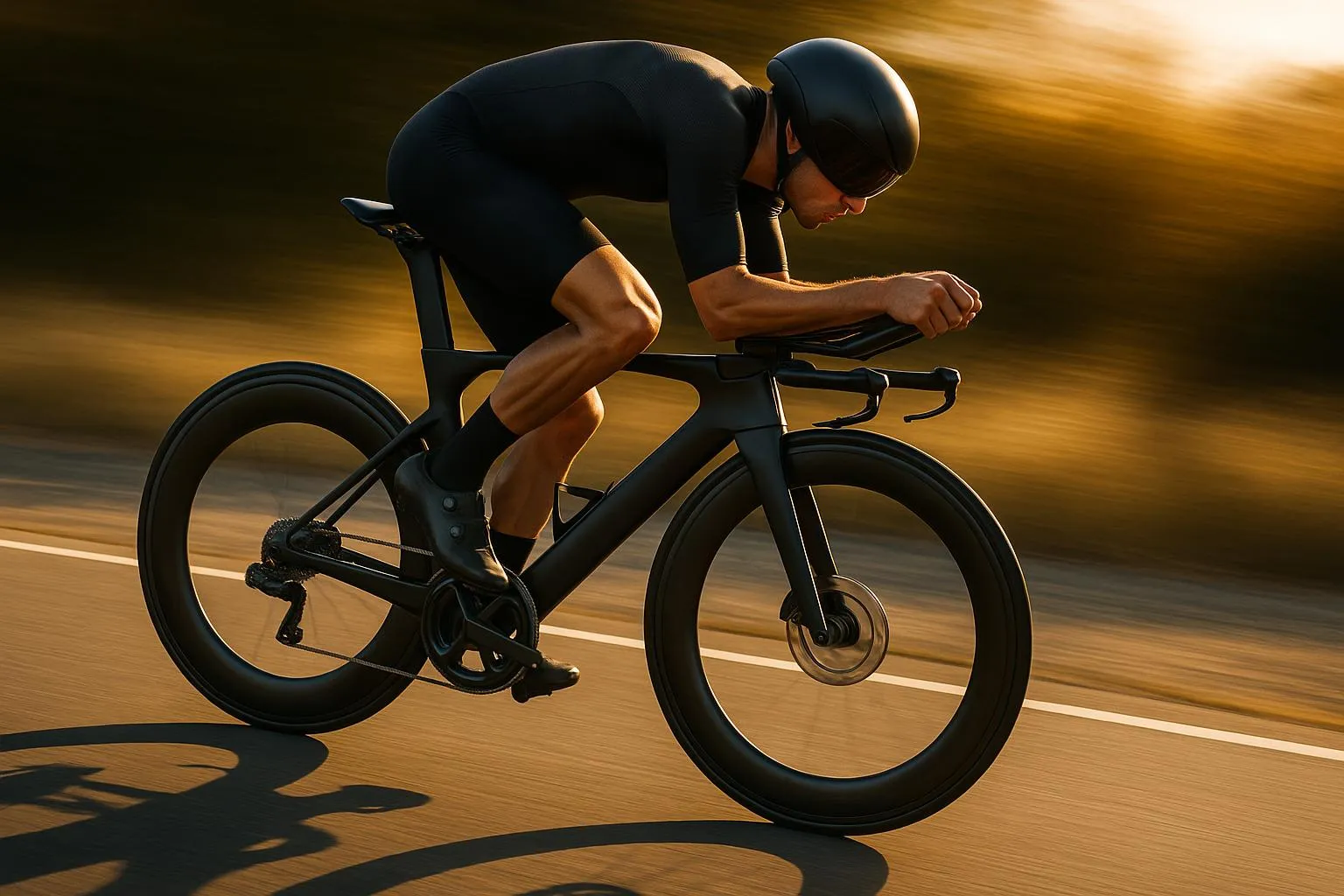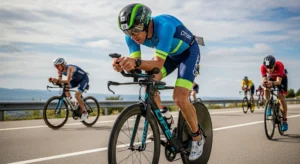The cycling world is experiencing an unprecedented aerodynamics revolution in 2025, fundamentally transforming how we think about bike design, performance optimization, and the very nature of competitive cycling. From the professional peloton of the Tour de France to the gravel racing circuits and everyday cycling enthusiasts, aerodynamics has emerged as the defining technological trend that’s reshaping the entire industry.
This revolution isn’t just about making bikes faster—it’s about reimagining the relationship between rider and machine, creating integrated systems that slice through the air with unprecedented efficiency, and democratizing aerodynamic advantages that were once reserved for elite professional cyclists. The implications extend far beyond racing, influencing everything from commuter bikes to adventure cycling equipment.
The Professional Racing Catalyst: Tour de France 2025 Sets New Standards
The 2025 Tour de France served as the ultimate showcase for this aerodynamics revolution, with teams abandoning traditional approaches to bike selection and embracing what experts are calling the “do-it-all aero bike” philosophy [1]. This fundamental shift represents one of the most significant changes in professional cycling strategy in decades.
Traditionally, professional teams maintained separate fleets of bicycles optimized for different terrain types: lightweight climbing bikes for mountain stages, aerodynamic time trial machines for races against the clock, and balanced road bikes for flat stages. This approach required teams to make strategic compromises, often sacrificing aerodynamic efficiency in the mountains or carrying weight penalties on flat terrain.
The 2025 Tour de France shattered this conventional wisdom. Teams like Visma-Lease a Bike, UAE Team Emirates-XRG, and Red Bull-Bora-hansgrohe demonstrated that modern aerodynamic bikes could be engineered to meet the UCI’s 6.8-kilogram weight limit while maintaining their aerodynamic advantages [1]. This breakthrough eliminated the traditional trade-off between weight and aerodynamics, creating truly versatile machines capable of excelling across all terrain types.
The technical innovations driving this revolution are remarkable in their sophistication. Tadej Pogačar’s Colnago Y1Rs exemplified this new approach, featuring a meticulously weight-optimized setup that included stripped paint, elimination of bar tape and bottle cages, 140mm rotors instead of standard 160mm versions, and a lighter saddle configuration [1]. These modifications achieved a final weight of 6.89 kilograms while preserving the bike’s aerodynamic characteristics—a feat that would have been impossible just a few years ago.
Jonas Vingegaard’s new Cervelo S5 represents another pinnacle of this aerodynamic evolution, combining improved aerodynamic profiles with lightweight construction and featuring a SRAM Red AXS 1x setup that further reduces weight and mechanical complexity [1]. The bike’s design philosophy treats the rider and equipment as a single integrated system rather than separate components, reflecting the influence of aerodynamics engineers like Dan Bigham, Red Bull-Bora-hansgrohe’s Head of Engineering.
The Science Behind the Revolution: Understanding Modern Aerodynamics
The current aerodynamics revolution is built upon decades of research in computational fluid dynamics, wind tunnel testing, and real-world performance analysis. Modern aerodynamic design goes far beyond simply creating sleek-looking frames—it involves optimizing every aspect of the bike-rider system for maximum efficiency.
Contemporary aerodynamic bikes utilize sophisticated tube shaping that manages airflow around the frame, fork, and wheels. These designs create what engineers call “attached flow,” where air moves smoothly around the bike rather than creating turbulent wake patterns that increase drag. The integration of components—from handlebars and stems to seat posts and wheel systems—ensures that each element works harmoniously with the others to minimize air resistance.
The weight optimization techniques employed in 2025 represent a quantum leap in engineering precision. Manufacturers are using advanced carbon fiber layup techniques, hollow construction methods, and strategic material placement to achieve the UCI weight limit while maintaining structural integrity and aerodynamic performance. This level of optimization requires sophisticated computer modeling and extensive testing to ensure that weight reduction doesn’t compromise safety or durability.
Modern aerodynamic testing has also evolved significantly, with teams using on-road testing protocols that complement traditional wind tunnel data. This real-world validation ensures that aerodynamic improvements translate into actual performance gains across varying conditions, from crosswinds to drafting scenarios in the peloton.
The Gravel Cycling Aerodynamics Explosion
While professional road racing provided the initial catalyst, the aerodynamics revolution has found perhaps its most exciting expression in the rapidly expanding world of gravel cycling. The 2025 Eurobike exhibition in Frankfurt demonstrated that gravel bikes are no longer simply modified road bikes with wider tire clearances—they’ve evolved into sophisticated aerodynamic machines that rival their road-specific counterparts [2].
The transformation of gravel bike design philosophy represents a fundamental shift in how the cycling industry approaches off-road performance. Modern gravel bikes now feature deep-profile carbon aerodynamic rims, aerodynamic handlebars, and frame designs optimized for cutting through air resistance [2]. This evolution reflects the growing competitiveness of gravel racing and the recognition that aerodynamic efficiency provides significant advantages even on unpaved surfaces.
The integration of aerodynamic features into gravel bikes extends to every component system. Completely hidden cable routing has become standard, eliminating the drag-inducing external cables that characterized earlier generations of gravel bikes. Hidden seat binders and seamlessly integrated fork crowns that blend into down tube shapes create clean airflow paths that would have been unimaginable in traditional off-road bike design [2].
Perhaps most significantly, gravel bike manufacturers are developing aerodynamic water bottle solutions specifically designed for long-distance racing and adventure cycling [2]. These systems maintain hydration capacity while minimizing aerodynamic penalties—a crucial consideration for events that can last many hours or even days.
The tire size evolution in gravel cycling also reflects aerodynamic considerations. The trend toward 700x45mm and larger tires isn’t just about comfort and traction—wider tires can actually improve aerodynamics when properly matched with appropriate rim profiles [2]. This counterintuitive development demonstrates how sophisticated modern aerodynamic understanding has become.
Integration Revolution: The Future of Cycling Components
One of the most dramatic aspects of the 2025 aerodynamics revolution is the move toward complete component integration. This trend goes far beyond traditional concepts of aerodynamic optimization, creating entirely new categories of cycling equipment that blur the lines between individual components.
The development of fully integrated cockpit systems represents the cutting edge of this movement. These systems combine stems, handlebars, and brake/shift levers into single carbon fiber components designed primarily for aerodynamic efficiency [2]. Some manufacturers are even integrating GPS head units directly into these systems, creating seamless interfaces that eliminate the aerodynamic penalties associated with traditional computer mounting systems.
This integration trend presents both opportunities and challenges for the cycling industry. While the aerodynamic benefits are substantial, integrated systems raise concerns about serviceability, customization, and cost. Bike fitters and mechanics are adapting their approaches to work with these new integrated systems, developing new techniques for optimizing rider position and maintaining equipment.
The implications for everyday cyclists are significant. As integrated aerodynamic systems become more common in professional racing, the technology inevitably filters down to consumer-level products. This democratization of aerodynamic technology means that recreational cyclists can access performance advantages that were previously available only to elite athletes.
The Technology Transfer: From Pro Racing to Consumer Markets
The aerodynamics revolution of 2025 is notable not just for its technical sophistication but also for the speed at which innovations are transferring from professional racing to consumer markets. This acceleration reflects both the competitive pressures within the cycling industry and the growing sophistication of cycling enthusiasts who demand access to cutting-edge technology.
Consumer-level aerodynamic bikes now incorporate many of the same design principles and manufacturing techniques used in professional racing. Advanced carbon fiber construction, integrated component systems, and sophisticated aerodynamic shaping are becoming standard features rather than premium upgrades. This democratization of technology is transforming the cycling experience for riders across all disciplines and skill levels.
The influence of professional racing developments extends beyond just road cycling. The aerodynamic innovations pioneered in the Tour de France are being adapted for urban cycling applications, e-bike technology, and even indoor cycling systems. This cross-pollination of technology ensures that the benefits of the aerodynamics revolution reach the broadest possible audience of cycling enthusiasts.
Environmental and Sustainability Considerations
The aerodynamics revolution of 2025 also intersects with growing concerns about environmental sustainability in cycling. Improved aerodynamic efficiency translates directly into reduced energy requirements for maintaining speed, which has implications for both human-powered cycling and electric bike systems.
For traditional bicycles, better aerodynamics means that cyclists can maintain higher speeds with less effort, potentially making cycling a more attractive alternative to motorized transportation for longer distances. This efficiency improvement supports broader sustainable cycling initiatives and urban transportation planning efforts.
In the context of electric bikes, aerodynamic improvements can significantly extend battery range and reduce charging frequency. This efficiency gain makes e-bikes more practical for longer commutes and recreational rides, supporting the broader adoption of electric cycling technology.
The manufacturing processes associated with advanced aerodynamic bikes also reflect growing environmental consciousness. Many manufacturers are implementing more sustainable production methods, using recycled materials where possible, and designing products for longer service lives and better recyclability at end-of-life.
Impact on Training and Performance Optimization
The aerodynamics revolution is fundamentally changing how cyclists approach training and performance optimization. The availability of aerodynamically efficient equipment means that position optimization and aerodynamic awareness have become crucial elements of cycling performance, extending far beyond traditional power and endurance training.
Modern cyclists are increasingly incorporating aerodynamic position training into their routines, learning to maintain efficient body positions that complement their equipment’s aerodynamic characteristics. This integration of equipment and technique represents a more holistic approach to cycling performance that acknowledges the interconnected nature of rider and machine.
The data available from modern cycling computers and power meters allows riders to quantify the aerodynamic benefits of different positions and equipment choices. This real-time feedback enables more sophisticated training approaches that optimize both physiological and aerodynamic factors simultaneously.
Professional coaching methodologies are evolving to incorporate aerodynamic considerations into training plans and race strategies. Coaches now work with riders to develop position-specific fitness and the ability to maintain aerodynamic positions under fatigue—skills that are becoming as important as traditional power and endurance capabilities.




